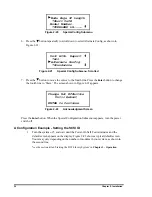
Chapter 2 - Installation
31
In the Base Module, each drive is wired to an independent SCSI bus, with a pair of connectors
for each bus. Because it can be used in free-standing applications, the Base Module also has a
pair of SCSI connectors for that module’s library robotics. The library robotics connectors
should not be connected when installed in a system with a Global Control Module. The
Capacity Module has no SCSI connectors, because it has no drives, and no independent
robotics. The Global Control Module controls the library robotics for all of the modules in the
system. It has a single SCSI bus, with a pair of SCSI connectors, to enable a host to control
the library robotics.
Each of the drives in the system and the library robotics is a separate SCSI device and is
wired to a separate SCSI bus. Any of the separate buses may be combined using a SCSI
jumper cable, available from Overland Data. If any two or more devices are connected to the
same SCSI bus, each must be assigned a unique SCSI address. For information on assigning
SCSI addresses, see the section headed ‘Configuration’ later in this chapter.
Note: For best performance, no more than four 2000 series drives, two 4000 series drives, or
one 7000 series drive should be connected to a single SCSI bus, because of the bandwidth
limitations of the SCSI bus.
A terminator of the proper type (50-pin single-ended or differential, or 68-pin differential)
must be installed on each unused connector at the end of each bus, as explained below in the
section headed ‘Interface Cable and Terminator Installation. Figure 2-13 shows the SCSI
cable, connectors and bus terminator used on the module.
In order to connect a module to a host computer system, the host system must have at least
one SCSI controller and the appropriate driver software. As noted earlier, higher-speed drives
may require the use of separate SCSI controllers for each drive or each pair of drives. No
more than one 7000 series drive, and no more than two 4000 series drives, should be
connected to a single SCSI bus. Your Technical Support representative is available to answer
your questions about installation procedures for specific host systems.
Before cabling the system, see the recommended SCSI cable specifications in the following
section. Also, see the section on Interface Cable and Terminator Installation later in this
chapter.
Interface Cable Specifications
The DLT LibraryXpress is a high-performance system. To avoid degradation of performance,
use the highest-quality interface cables. The detailed requirements for SCSI cables are set
forth in ANSI X3.131-1994. It is recommended that all SCSI cables used with the DLT
LibraryXpress Module meet at least the following requirements:
•
Shielded or double-shielded, as required to meet EMI specifications;
•
Impedance match with cable terminators of 132 ohms, ideally;
•
Characteristic impedance between 90 and 132 ohms, required;
•
50-conductor flat cable or 25-pair twisted-pair should be used;
•
Each end of the twisted pair ground must be connected to chassis ground;
•
The maximum cable length for a single-ended SCSI bus is 19.68 feet (6 m)*;
Summary of Contents for DLT LibraryXpress Series
Page 8: ......
Page 20: ......
Page 52: ......
Page 80: ......
Page 92: ......
Page 130: ......
Page 134: ...126 Appendix A Specifications...
Page 135: ...Appendix A Specifications 127 a p a c i t y C C a pa city C C...
Page 136: ...128 Appendix A Specifications...
Page 138: ......
Page 140: ......






























